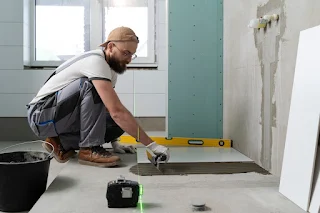Water Proofing
Waterproofing is the process of making an object or structure resistant to the penetration of water or moisture. There are various methods and types of waterproofing, each suited to specific applications and materials. Waterproofing protects structures against water infiltration which can cause expensive and irreversible damage. It is mostly invisible after construction is completed. Every day the basement of a building, or the outermost layer of a tunnel, is exposed to intense fluctuations in moisture levels and temperatures, all contributing to its deterioration.
Here are some common types of waterproofing:
1) Membrane Waterproofing: Membranes are applied to surfaces as sheets, sprays, or liquids to create a waterproof barrier. These membranes can be made from materials like bitumen, PVC, TPO, EPDM, or even bentonite clay.
2) Cementitious Waterproofing: This method involves applying a cement-based mixture that forms a rigid, waterproof coating when it dries. It is often used in construction to waterproof basements, tanks, and swimming pools.
3) Liquid Waterproofing Membrane: Liquid-applied waterproofing membranes are typically made of flexible, polymer-modified asphalt or other elastomeric materials. They can be applied in multiple coats and are often used on roofs and decks.
4) Sheet Membrane Waterproofing: These are pre-fabricated sheets made of materials like modified bitumen or synthetic rubber. And they are applied to surfaces by rolling or adhering, creating a waterproof barrier.
5) Bentonite Waterproofing: Bentonite clay is used in this method. It swells when it comes into contact with water, forming a watertight seal. It is often used in below-grade applications.
6) Polyurethane Waterproofing: Polyurethane waterproofing coatings are durable and flexible. They are often used for roofs, decks, and basements.
7) Silicone Waterproofing: Silicone-based coatings are known for their excellent resistance to UV rays and weather. They are often used in exterior applications.
8)Injection Waterproofing: This method is used to seal cracks and joints in existing structures by injecting a waterproof material (often epoxy or polyurethane) into them.
9) Integral Waterproofing: This involves adding waterproofing agents directly to the concrete or mortar mix during construction. It is a preventative measure used in building foundations and walls.
10) Roofing Membrane Waterproofing: These specialized membranes are designed for use on flat or low-slope roofs. They can be made from various materials like EPDM, TPO, or PVC.
11) Exterior Waterproofing: This involves excavating around the exterior of a building's foundation and applying a waterproof coating or membrane to the outer surface to prevent water infiltration.
12) Interior Waterproofing: This method addresses water infiltration from inside the structure. It may involve installing drainage systems, sump pumps, or applying sealants to interior surfaces.
13) Crystalline Waterproofing: This type of waterproofing relies on crystalline compounds that penetrate the concrete and create a waterproof barrier as they react with moisture.
14) Green Roof Waterproofing: For green or living roofs, specialized waterproofing systems are used to protect the building structure from moisture while supporting vegetation.
15) Swimming Pool Waterproofing: Swimming pools require specialized waterproofing to prevent water leakage. Waterproofing membranes or coatings designed for pools are commonly used.
The choice of waterproofing method depends on factors such as the type of structure, the materials involved, the location, and the specific waterproofing requirements. Each type of waterproofing has its advantages and limitations, so it's important to select the most appropriate method for the intended application.










